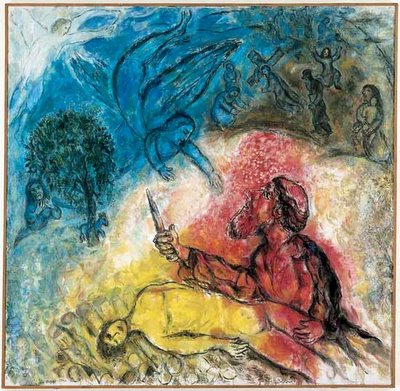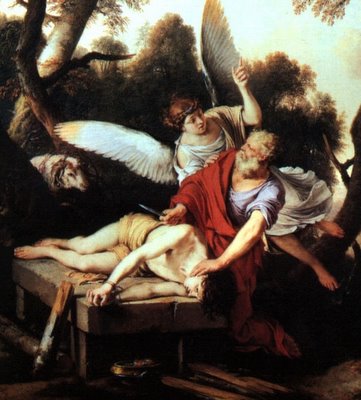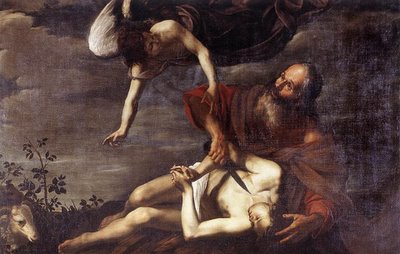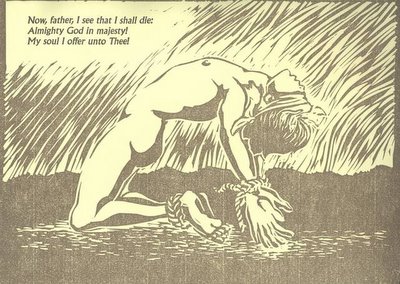Bound

After composing my earlier post in which I made reference to the Eid ul-Adha (عيد الأضحى)/Kurban Bayramı, it occurred to me that I shouldn’t pass up an opportunity to post some more homoerotic Christian art.
This important Islamic holiday commemorates Abraham’s willingness to sacrifice his only son Isaac when God asked him to. Personally, I find the story rather disturbing, as are many of the Bible stories that portray the vengeful and jealous tribal deity that was an early and primitive iteration of Judeo-Christian monotheism. But that’s not the point of this post. The point is to share some images that portray Isaac not as a little boy, as he is often conceived, but as a beautiful, muscled youth.
 In most of these images, Isaac is nude or nearly nude, often bound and in some cases even blindfolded. The degree to which Isaac struggles varies, and his expression ranges from sorrow and fear to resignation. Sometimes he is on his knees, while at other times he lies passively on the altar. The overall impression is one of exposure and vulnerability. In many ways the images of Isaac are evocative of the martyrdom of Saint Sebastian or of the crucifixion. In fact, Orrente’s Isaac (third from top) is remarkably similar to his depiction of Saint Sebastian, done in the same year (1616) and arguably using the same model. Similarly, in Chagall’s The Sacrifice of Isaac (top), an image of Jesus carrying his cross on his way to Golgotha hovers in the right-hand corner.
In most of these images, Isaac is nude or nearly nude, often bound and in some cases even blindfolded. The degree to which Isaac struggles varies, and his expression ranges from sorrow and fear to resignation. Sometimes he is on his knees, while at other times he lies passively on the altar. The overall impression is one of exposure and vulnerability. In many ways the images of Isaac are evocative of the martyrdom of Saint Sebastian or of the crucifixion. In fact, Orrente’s Isaac (third from top) is remarkably similar to his depiction of Saint Sebastian, done in the same year (1616) and arguably using the same model. Similarly, in Chagall’s The Sacrifice of Isaac (top), an image of Jesus carrying his cross on his way to Golgotha hovers in the right-hand corner. This is probably the closest I’ll ever get to posting anything even remotely fetishistic. So I hope all you BDSM types out there enjoy this.




 From top to bottom the images are: Marc Chagall’s (1887-1985) The Sacrifice of Isaac (c. 1960, oil on canvas, Chagall Museum, Nice); Jacopo Ligozzi’s (1547-1626) Sacrifice of Isaac (c. 1596, oil on wood, Galleria degli Uffizi, Florence); Pedro Orrente’s (1580-1644) The Sacrifice of Isaac (1616, oil on canvas, Museo de Bellas Artes, Bilbao); Laurent de La Hire’s (1606-1656) Abraham Sacrificing Isaac (1650, oil on canvas, Musée Saint-Denis, Reims); Orazio Riminaldi’s (1593-1630) Sacrifice of Isaac (c. 1625, oil on canvas, Galleria Nazionale d'Arte Antica, Rome); Caravaggio’s (c. 1571-1610) The Sacrifice of Isaac (c. 1605, oil on canvas, Piasecka-Johnson Collection, Princeton, NJ); J. Martin Pitts (1939–2002), Abraham and Isaac: a text from The Chester Miracle Plays (The Old Stile Press, 1999).
From top to bottom the images are: Marc Chagall’s (1887-1985) The Sacrifice of Isaac (c. 1960, oil on canvas, Chagall Museum, Nice); Jacopo Ligozzi’s (1547-1626) Sacrifice of Isaac (c. 1596, oil on wood, Galleria degli Uffizi, Florence); Pedro Orrente’s (1580-1644) The Sacrifice of Isaac (1616, oil on canvas, Museo de Bellas Artes, Bilbao); Laurent de La Hire’s (1606-1656) Abraham Sacrificing Isaac (1650, oil on canvas, Musée Saint-Denis, Reims); Orazio Riminaldi’s (1593-1630) Sacrifice of Isaac (c. 1625, oil on canvas, Galleria Nazionale d'Arte Antica, Rome); Caravaggio’s (c. 1571-1610) The Sacrifice of Isaac (c. 1605, oil on canvas, Piasecka-Johnson Collection, Princeton, NJ); J. Martin Pitts (1939–2002), Abraham and Isaac: a text from The Chester Miracle Plays (The Old Stile Press, 1999).












3 Comments:
I dont get it .. if this holiday was ment to remeber the incident of isaac then why kill poor animals claiming it to be in a similar settings.. stupid! the poor animals.
I understand your ambivalence, but the incident can also be read as the Deity's renunciation of human sacrifice as an appropriate tribute. Once Abraham and Isaac's loyalty and obeience is tested (admittedly somewhat sadistically) the deity sends the angel to stop the sacrifice and authorizes the substitution of animals instead.
Many of the Greek plays (which in some ways serve the same functions as the Hebrew Bible) memorialize major social and legal changes--"The Eumenides," for example depicts the establishment of the jury system in place of the old murder-in-revenge-for-murder ethic).
At some time or other in their histories, all ancient civilizations came to a point where they renounced human sacrifice. Abraham, newly departed from Mesopotamian religions, probably did that for the Jews in this story.
Brilliant comment, Will. You're quite right; I was focusing on the micro at the expense of the macro. I was preoccupied with the element of cruelty in the story and neglected the larger socio-cultural shift that the story encapsulates. I think it's a vestige of our (or my) tendency to read these stories literally instead of allegorically as they were intended.
I was also preoccupied with all the skin, but nobody would blame me for that :)
Thanks for reading!
Post a Comment
<< Home